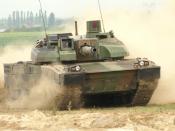The French are often criticized for their poor military record, often insulting the attitudes of the French people themselves. But why did the French really lose so often in combat? Their military tactics were horrendous, their armor was impractical, their formations were illogical, and their weapons were ineffective.
The most important part of the battle, according to French officers, was having an effective defense. This all started with armor. In the early 1400s the offensive attacks had increasingly been carried out primarily with long-range weapons, such as crossbows and longbows. Because of this, iron plated shields replaced the previous leather shields. However, the typical iron armor of this time weighed 130 to 175 pounds, an incredible load to bear (Duby, 155). Not only could a warrior with this armor on walk only straight, but also he could only strike at things directly in front of him. In addition, he could not make ordinary gestures, and he would have been "unable to lift himself up if he falls to the ground, and, if the ground is muddy, he is bogged down in it."
(Duby, 155). This was a very harsh change for the soldiers who had previously been used to leather shields, an incredibly light armor but extremely ineffective in stopping arrows.
This new armor did not only cause a problem because of how difficult it made hand-to-hand combat, but it also made the possibilities of cavalry greatly less: not only could horses not carry such heavy riders very far or very fast, but because the horses quickly died from the arrows of arches and crossbowmen (Duby, 156).
These problems did not go without an answer. A new formation, called a "lance", was developed to minimize their army's weaknesses. The lance consisted of a horseman, two arches (who were mounted as...



True
The French army was proven to be weak throughout the history. WWI and WWII...the only good thing i remembered about the French army was when Napoleon controlled it...
4 out of 4 people found this comment useful.